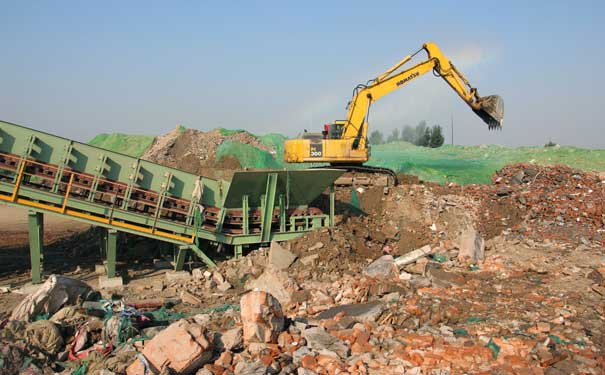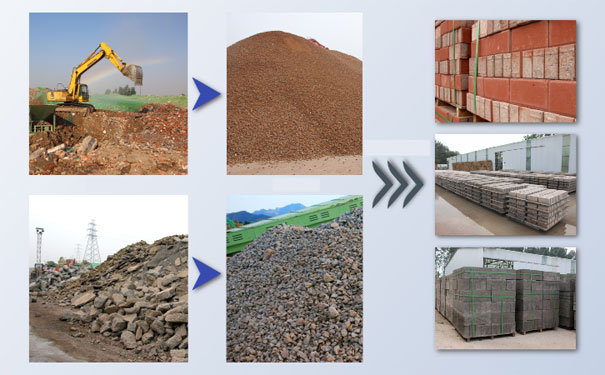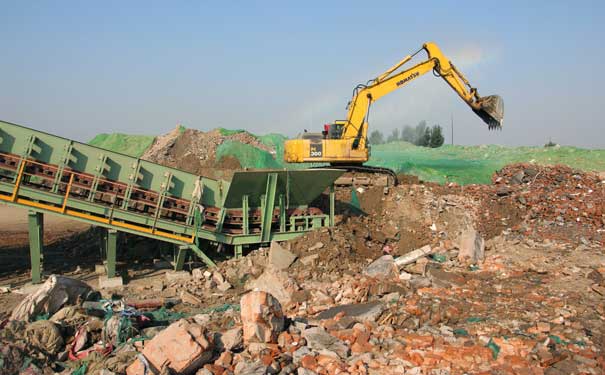Construction waste is the muck, spoil, spoil, and other waste generated during the construction and demolition of various buildings, structures, pipe networks, etc., by construction, construction units or individuals. With the development, more and more construction waste is generated from the construction of houses. Most construction waste is directly piled up in the open or land filled. The land resources will be occupied and dust will cause serious pollution to the environment. Construction waste will be piled for a long time. And landfills will penetrate into the soil and cause pollution to the soil and groundwater. The treatment of construction waste is also gradually improving. For example, waste building concrete, waste bricks and other materials can be used to produce coarse and fine aggregates for making wall panels, floor tiles and base layer of highway pavement.

Concrete blocks are generally about 50cm in size, and small ones are about 5cm in size. Generally, two types of crushing are fixed crusher or mobile crusher. If the customer requires flexibility and space is not limited, the mobile crusher is more appropriate; if the customer only requires low cost and no site requirements, then fixed crusher equipment should be used.
Stationary crusher
Category: jaw crusher, construction waste crusher, ZSW series vibrating feeder, YKR series circular vibrating screen, PFQ series powerful vortex impact crusher
Output: 100t/h
Finished products: 0-5mm, 5-10mm, 10-20mm, 20-31.5mm aggregates; recyclable metals, etc.; final products: recycled bricks, permeable concrete, etc.
Equipment features: relatively low investment cost, large output, and large crushing ratio, suitable for fixed operating sites.
Mobile concrete crushing machinery and equipment
The mobile breaker is actually composed of equipment such as jaw breaker, impact breaker, and tire steel frame body or all-steel hydraulic crawler chassis. In fact, the performance is not bad at all, but its mobility, adaptability and intelligence are enhanced. A cumbersome installation process is needed, and it does not take too much floor space.
The mobile concrete crushing machinery has a relatively compact structure, which can ensure normal operation even in a narrow and harsh environment. There is also a diesel power generation device, which provides a more convenient choice for users who frequently change sites. Centralized electronic control system, allowing workers to detect or adjust operation in real time only through the display and keyboard.
Both the fixed crusher and the mobile crusher can crush concrete blocks for processing. To choose the quality of the crusher, it is necessary to comprehensively compare the advantages and disadvantages of the equipment. Whether it is fixed or mobile, it has its characteristics and advantages. If you want to do engineering, there are more venues. You can choose a mobile crushing station, although the initial cost investment is more, but the payback is faster in the later stage. It is not restricted by region, multiple sites work back and forth, and the operation labor cost is also low. If you own a construction site and the production is relatively fixed, you can choose a fixed crusher, and the overall cost is more appropriate.

Can concrete be used as a stone after it is broken?
Stones and sand are usually used to configure concrete and pave the road base. There are two domestic planning standards for them: “Sand and Stone for Concrete” and “Sand and Stone for Construction”. The regulations clearly stipulate the particle size, hardness, and mud content. In terms of volume, density and crush value, most of the concrete itself is not low in hardness, as long as it is processed through a reasonable process, it can fully meet these standards
Even the concrete made into sand can be re-applied and sold, and my country’s West Xianbei Ring Expressway is built with treated construction waste as the main aggregate. The entire filling layer and roadbed are made of muck and soil. Recycled sand and gravel aggregates have also been tested layer by layer before it has shown that the broken concrete can be used as stones.

